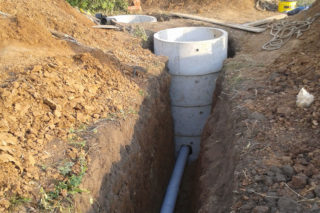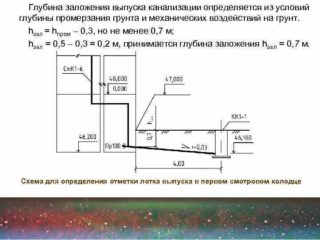It is real and not difficult to create comfortable conditions, thanks to technologies and various materials, in an individual residential development. One of the main points of increasing comfort is communications, sanitary facilities, and, consequently, technical conditions for the efficient and uninterrupted operation of devices and systems.
A prerequisite is the correct laying of the sewer line. The term "correct" means compliance with SP 55.13330.2016 "Single-family residential houses", SNiP 2.04.03-85 clause 4.8., SNiP 31-02-2001. The technical conditions include such as the depth of the septic tank, laying of pipes, the cross-section of drainage pipes and others.
What determines the depth of the laying
Specific values for all conditions that would be regulated by SNiPs are not indicated in the standards. For each location, the depth of the pipes for the drainage system has its own parameters. This parameter depends, first of all, on the climatic zone, the nature of the soil and the type of sewer system.
Above or below the level of soil freezing
Installation can be carried out both above and below the level of soil freezing. But in any case, this indicator should be taken into account. When the pipeline is installed in the freezing zone, it is insulated with special heat-insulating materials, and heating can be additionally installed.
It is not difficult to deepen the sewer wire in climatic zones with a moderate minus mark in the cold season. In regions where the temperature in winter drops below -20 and is not uncommon, the depth of the frozen layer ranges from 1.5 meters or more. It is difficult to dig a trench of such depth on your own, especially if the installation of a septic tank is planned at a considerable distance from the building. In addition, some septic tanks involve laying the pipeline no more than 1 meter 40 centimeters deep.
In such conditions, it is advisable to install a heating cable, which turns on when there is a risk of freezing.
But even for zones with a deep layer of freezing, technically, there is no need to deepen the sewer pipeline. The fact is that if all the recommendations for technical specifications are followed, then there is nothing to freeze in the pipes. All incoming liquid biomaterial will drain immediately into the container. For this, a slope is created, equal for each meter, 2-3 centimeters. The water with which the waste is washed off has room temperature and should not freeze during the moment it moves through the pipes. The exceptions are situations when the pipe lumen is significantly narrowed due to blockage. But this is not a standard situation requiring urgent elimination.
How to choose the right placement depth
Optimum depth of sewer pipes
The classic depth starts from half a meter from the house, gradually deepening towards the septic tank.The deepening to the septic tank is calculated based on the instructions for use of the product. For example, the Topaz septic tank provides for a maximum pipe occurrence of up to 1.4 meters.
Provided a straight pipeline, it can be deepened to a great depth, without fear of blockages.
The depth of soil freezing depends not only on the climatic zone, but also on the nature of the soil. For example, clay soils and loams in the Moscow region have a freezing depth of 1.1 meters, and sandy soils freeze up to 1.44 meters. In the Adler region, this parameter does not fall below 0.8 meters.
SNiP recommendations
According to SNiP, the location of the branch pipes leaving the room should be 30 cm higher than the freezing depth.In this case, the depth of the trench is within 70 cm.If the movement of machines is expected above the pipeline, or a significant snow (other static) load, then the depth is increased, to prevent pipe damage and freezing.
It is good to ask the neighbors what kind of sewage system they use and how efficient it is in their work. Taking into account the size of pipes, elbows, depth and angle of inclination. If in a neighboring section, with the specified parameters, the pipes do not freeze in winter, and the system functions without interruption, then it is better to focus on such a positive experience. The fact is that a soil map will not give a clear understanding of the nature of the soil at a particular point. Official information takes into account the general situation over long distances. For a specific location, it is better to rely on existing experience.
Output
As a heater, polyurethane is used, on top of which a layer of film is laid.
It also makes sense to insulate the pipe section at the exit from the room and before deepening. If this area is open, a heating wire can be added in addition to the thermal insulation.
The legal framework does not take into account the effectiveness of the system in many respects, and it makes no sense to rely on the standards from this point of view. But they must be taken into account. And in technical terms, it is better to be guided by the experience of specialists who have already repeatedly launched sewerage systems in a particular area.
When designing, it is good to avoid turns and connections as much as possible. The fewer there are, the more reliable the pipeline system as a whole.











